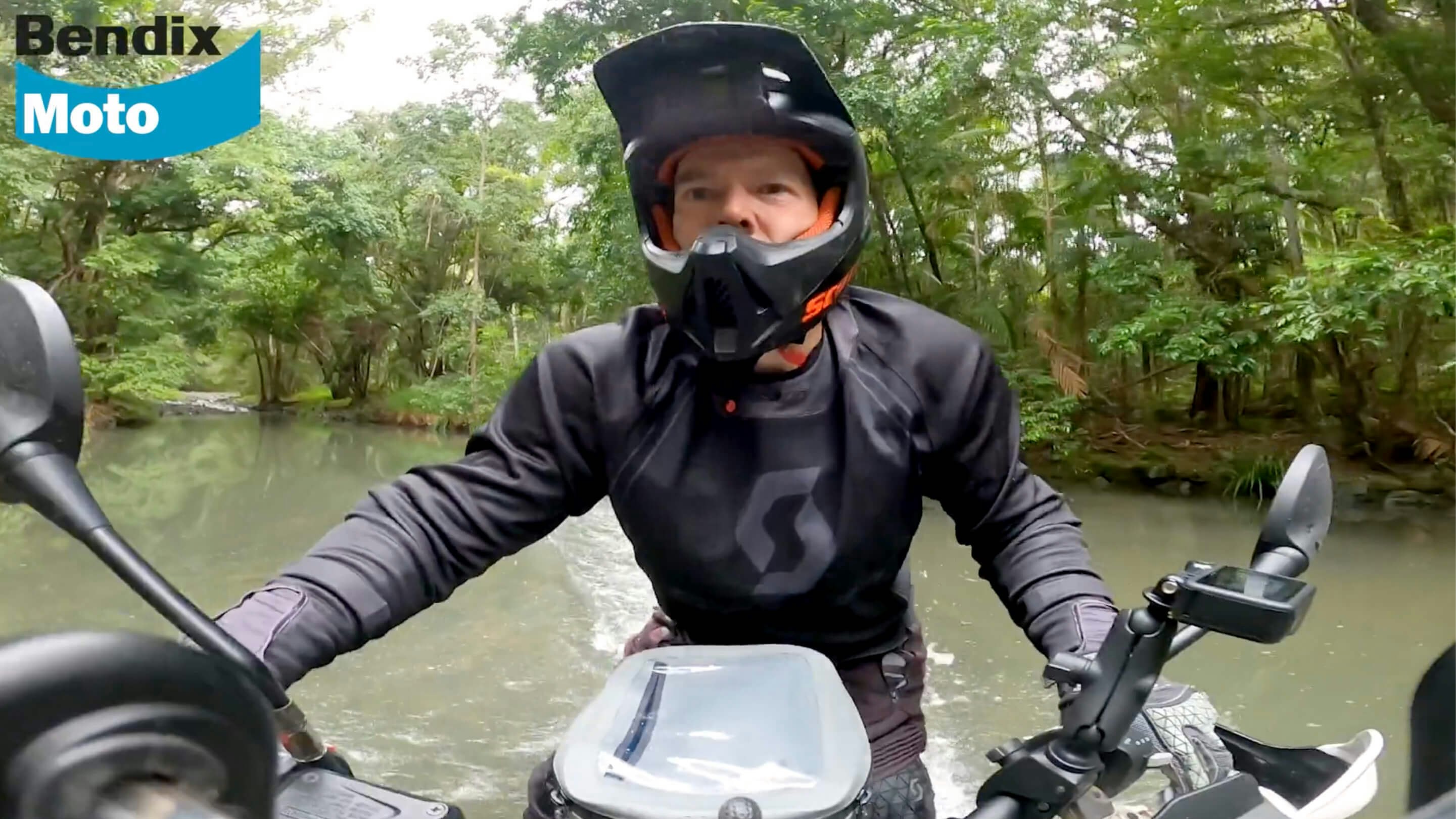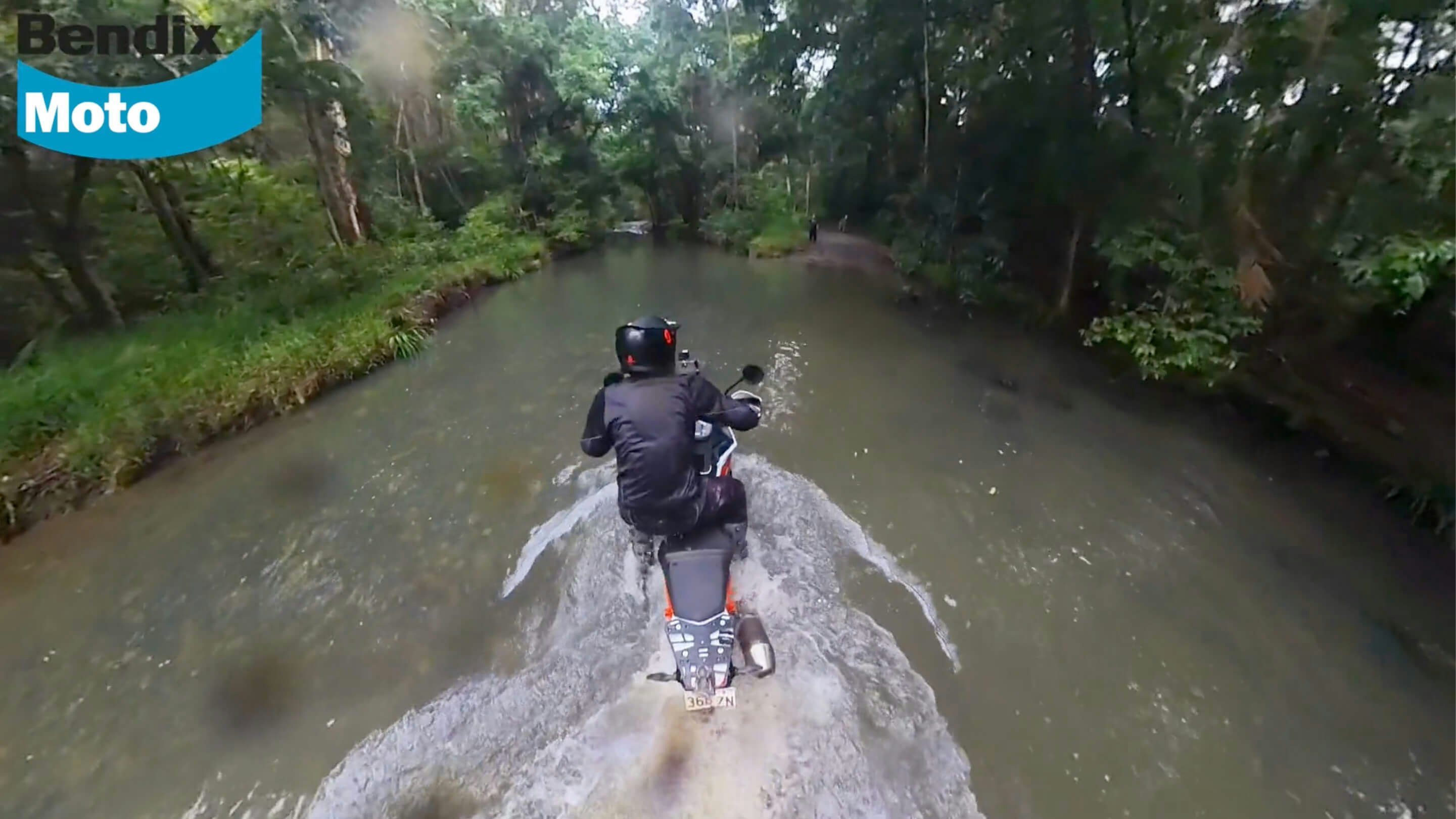Adventure water crossings

Depending on where you ride off road, chances are that at some point you’ll have to negotiate a river crossing, particularly if riding during the wetter times of the year. River crossings can be exhilarating but challenging as well, especially through deeper water which can hide obstacles such as logs or large rocks.

As a component supplier to the motorcycle industry, Bendix understands the important safety considerations that riders need to take when riding off road, that’s why Bendix has partnered with the renowned rider training team at motoDNA. Together we’ve developed a series of tutorials that impart the knowledge of motoDNA’s experienced trainers, for bikers to apply to their own riding both on and off the road.
In this installment, we guide you through water crossings. And if you missed our two earlier articles on riding hills, and turning on hills, be sure to check them out.
Tackling water crossings
When confronting a river the rider must decide whether to cross it or not. Their decision will depend on several factors, including their appetite for risk and the level of confidence they have in their riding abilities. Another consideration is how far away help is should the situation turn sour – is the rider remote, or on a local ride? This makes a big difference, as will whether the rider is by themselves or travelling with mates who can help out?
If the decision is made to attempt the river crossing, there is a process that the rider should follow.
Assess the river
The starting point is to assess the river and pick a riding line. If possible, the rider should get to an elevated position near the river to help minimise the glare, then try to spot any rocks or obstacles. An even better option is to walk the crossing; as well as helping identify potential obstacles, this will give the rider an indication of water depth.

There are a couple of things to be weary of though, including crocodiles, particularly in the north of the country, and ‘still waters run deep’. If the rider drops the bike, they can drown their engine and this can lead to serious damage if water gets ingested into the internals, so they need to be ready with the engine kill switch. They also need to be aware of their airbox intake position, and all the time be mindful that adventure bikes weigh well over 200kg – they don’t want to drop the bike and have it pin them in the water during the crossing.
Load the engine
With these precautions taken and the rider now committed to attempting the river crossing, they need to load the engine the whole way through the crossing, especially at entry. If the entry is downhill, the rider should also engage their rear brake and begin away from the river bank, as this will give them enough time to get into the correct body position.
Engine revs should be maintained with a steady throttle throughout the crossing and the clutch used to control power and speed. Clutching helps the bike to track straight without shutting the throttle, as the bike will buck and weave as it traverses the underwater obstacles.

Body position
Standing up is best for control and stability – riders should take an aggressive body position; butt should stick out with knees bent, this lowers the centre of gravity and makes the rider more agile on the bike.

The rider will need to intuitively react to the bike moving around underneath them. Head-up optimises balance, and eyes forward will help the rider pick / stay on their line.

If things begin to go wrong, the rider shouldn’t panic; they should drop onto the seat and put their feet down, they should then try to weight the rear tyre for grip to help get moving again. Practicing in a dry river bed is great for building confidence and skill.

A special mention of causeways – these can be treacherous with slippery algae. It’s best to take these crossing slowly and be seated, so the rider reduces their centre of gravity should they lose traction.

After a water crossing, it’s a good idea to check the brakes before resuming any spirited riding. Wet discs and pads may temporarily result in reduced braking performance until the components dry out.
And after extended time on the trials, particularly if covering more extreme terrain, it’s also vital to treat the bike to a good mechanical check over to identify any potential issues before hitting the tracks again.
Given the impact that good brakes have on the overall performance of a bike and for the safety of the rider, the braking system should be a priority in any maintenance checks. As a leading manufacturer of quality brake pads to the motorcycle industry, Bendix through its Bendix Moto range, offer a selection of brake pad options designed to give the rider superior stopping power coupled with durability and excellent braking feel.
The Bendix Moto range consists of Ultimate+ and Street Road Track pads.

While Street Road Track pads are designed predominantly for performance mid and high-capacity sports bikes, the Ultimate+ range is perfect for trail and adventure bikes. Ultimate+ pads use dense ceramic materials that provide maximum durability and braking feel in all conditions. Ultimate+ also feature embedded fine copper fibres that increase friction and heat conductivity, while delivering low dust and noise performance.
Options are available to suit a wide variety of bike classes with pads to suit many Japanese, European, American and Chinese brands.
And if riders are looking to further their trail riding skills, they should consider participating in programs run by reputable providers such as motoDNA. This training prover offers both traditional courses, through to programs overseen through the innovative Digital Academy, which is a data-driven platform that lets riders practice their riding skills at their own pace, in their own time and on their favourite roads and trails.
Ride safely — Find the right brakes for your bike

 Australia
Australia
 New Zealand
New Zealand